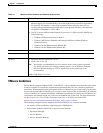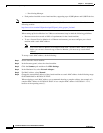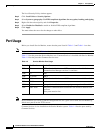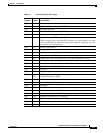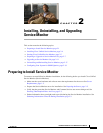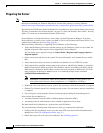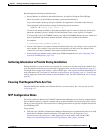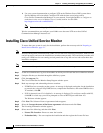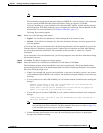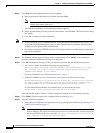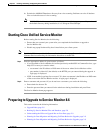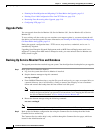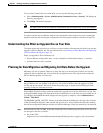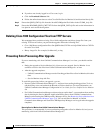
2-3
Installation Guide for Cisco Unified Service Monitor
OL-25111-01
Chapter 2 Installing, Uninstalling, and Upgrading Service Monitor
Preparing to Install Service Monitor
Read through the following installation notes:
• Service Monitor is installed in the default directory SystemDrive:\Program Files\CSCOpx
where SystemDrive is the Windows operating system installed directory.
If you select another directory during installation, the application is installed in that directory.
The destination folder should not contain the following special characters:
! @ # $ % ^ & * ( ) + | } { " [ ] ; ' / ? < > , . ` =
If errors occur during installation, check the installation log file in the root directory on the drive
where the operating system is installed. Each installation creates a new log file; for example:
C:\Ciscoworks_install_YYYYMMDD_hhmmss.log, where YYYYMMDD denotes the year, month and
date of installation and hhmmss denotes the hours, minutes and seconds of installation.
For example:
C:\Ciscoworks_install_20060721_182205.log
• You can click Cancel at any time to end the installation. However, any changes to your system will
not be undone. For example, if any new files were installed or if there were any changes to the
system files, you need to manually clean up the installation directories.
• To monitor Service Monitor using a third-party SNMP management tool, see Configuring Your
System for SNMP Queries, page 2-19.
Gathering Information to Provide During Installation
During installation, you will need to set passwords for various user accounts and for the database. For
more information about the user accounts and for password rules, see Password Information, page A-7.
You might need to supply mail settings—such as HTTPS port—and security certificate information. For
more information, see User Inputs for Installation, Reinstallation, and Upgrade, page A-1. You will also
need to supply the license file location or select Evaluation only. For more information, see Licensing,
page B-1.
Ensuring That Required Ports Are Free
The ports that Service Monitor and Common Services use must be free. For a list of ports, see Port
Usage, page 1-8.
NTP Configuration Notes
The clocks on Service Monitor and Unified Communications Manager servers must be synchronized for
Service Monitor reports to include complete and up-to-date information and accurately reflect activity
during a given time period. These notes offer a starting point and do not provide complete instructions
for configuring NTP.
To get started:
1. Talk with your Unified Communications Manager administrators to determine the time server with
which Service Monitor should synchronize. You might find Cisco IP Telephony Clock
Synchronization: Best Practices, a white paper on Cisco.com, useful; read it at this URL:
http://cisco.com/en/US/products/sw/voicesw/ps556/prod_white_papers_list.html.



